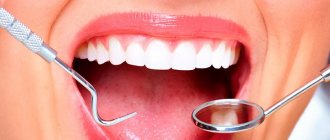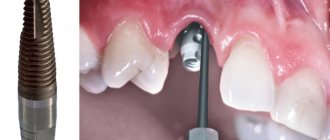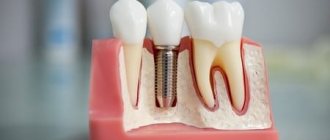After tooth extraction, the state of the dental system changes, the chewing load is redistributed, the bone tissue in the resulting gap is stabilized, and the hole is overgrown. All changes occur gradually, but over time the consequences manifest themselves in the form of bone atrophy, changes in the bite and subsidence of the gums. Is it possible to place an implant immediately after removal? Only an experienced specialist will answer the question, since it directly depends on the patient’s health condition. What implantation methods do modern dentistry offer and when can a dental implant be installed? Let's take a closer look.
When can a dental implant be placed after tooth extraction?
There are several methods for installing dental implants: two-stage, one-stage, one-stage. The latter is used immediately after tooth extraction. Its main difference is that the patient should have no contraindications for the operation, and the implantologist is fully prepared for the intended procedure. In practice, simultaneous implantation is rarely carried out, since most often they end up in the dentist’s chair too late, when the disease has progressed to an acute or chronic stage, severe pain has appeared and emergency removal is required. During a planned removal, the implantologist has from 2 to 14 days to prepare: collecting tests to identify contraindications, making casts of the jaw and a surgical template, selecting medications and creating a crown for the implant.
What can be put in place of an extracted tooth?
There are many options for replacing an extracted tooth. An experienced orthopedic surgeon will offer removable and fixed structures, solutions for restoring individual teeth or a number of missing units, and reconstruction of a completely edentulous jaw. For each case, protocols, methods, and treatment techniques are provided.
How to insert a tooth in place of a removed one - options:
- prosthetics on dental implants;
- bridge prosthesis;
- removable prosthetics;
- clasp prosthesis.
What can be put in place of an extracted tooth depends on:
- number of units removed;
- condition of bone tissue;
- dental diagnoses;
- patient's age.
Based on the preliminary diagnosis, the doctor makes a decision on the timing and features of treatment.
Pros and cons of implantation immediately after tooth extraction
Unlike classic removable prosthetics, a dental implant has many advantages: 1. Natural pressure is applied to the bone tissue, comparable to the load on your own tooth root. For this reason, atrophy does not progress, the process slows down, and when choosing high-quality implants, changes do not affect the gums for more than 5 years; 2. Reliable fixation of the prosthesis in the mouth allows you to eat your usual food and perform oral hygiene using conventional means; the prosthesis does not interfere with diction, feels like one’s own tooth, without changing the patient’s usual lifestyle; 3. You can chew with dental implants installed immediately after tooth extraction, after their complete healing, just like with your own teeth. In terms of reliability, they are not inferior to conventional implants installed using other methods; 4. When installing an implant on the day of removal, bone tissue augmentation is not required or is minimal (bone material is added to the tooth socket during the operation). This approach significantly saves time for more complex bone augmentation operations (can take from 3 to 6 months); 5. The patient needs to visit the dentist less, both for diagnosis and for surgery and subsequent monitoring. Time is saved for travel and doctor appointments without loss of quality; 6. Neighboring teeth are preserved, since implantation does not require additional supports or preparation of other teeth. In the long term, this will save teeth from falling out and destruction; 7. The service life of a dental implant is from 8 to 15 years if it belongs to the economy class segment, from 10 to 20 years in the middle segment, and premium class implants last more than 20 years. Removable dentures require adjustment and replacement on average every 5 years, while the reliability of the fit is less due to changes in bone tissue.
Let's return to the problem of delayed dental implantation
And let's talk about the situation when a patient decides to have an implant installed 5-10-15 years after its loss. Let’s call it the general term “implantation after some years.”
In implantation, after “some” years, even installing one implant in the chewing area can actually become a big problem.
Implantation in the chewing area
The problem may arise that a traumatic removal of this tooth from the chewing area was previously performed. If a traumatic extraction is performed in the area of the 6th upper or 6th lower tooth or the bone tissue has narrowed, then bone augmentation must be done, because the bone tissue is narrow. There is a problem there, yes. Precisely with bone tissue growth. This problem is quite complex, and for the patient it is an unpleasant procedure. Unpleasant in what way?
The fact is that the patient will be uncomfortable for some time after bone grafting.
The following discomfort is possible after bone grafting:
- there will be swelling,
- chewing will be difficult, you can only eat on the other side of the teeth,
- pain will occur.
Pain after bone grafting depends on the patient’s pain sensitivity threshold. There is really no need to be afraid of pain. There are drugs that reduce this sensitivity and act as a complete pain reliever. The painful moment in implantation and bone grafting is a quickly passing phenomenon, and it is not so tragic.
In November 2022, my colleague, implant surgeon at the Research Center Kolushev Gleb Valerievich personally performed dental implantation in the masticatory region for me, as a patient. Two Astra Tech implants with sinus lift were installed. Below in the video I attach a report on the progress of the operation and my personal feelings:
Dental implantation in the anterior region
Another question is if you need to install an implant in the frontal region, i.e. in the area of the front teeth. In the anterior region, it is more difficult to implant a tooth, because the anterior teeth are an aesthetically significant area:
It will be necessary to do both plastic surgery of the bone material and plastic surgery of the soft tissues, that is, plastic surgery of the mucous membrane. And this is a rather serious point, the doctor must be professionally savvy in this matter, and the process of implantation in combination with plastic surgery turns from a momentary procedure into a complex sequential process that requires quite a lot of time.
Why? Because even 1-2 years are needed to get a good result. What do patients usually need? - so that he comes today
, and
tomorrow
he has already become the most beautiful.
This metamorphosis is not only in the field of implantology, it exists everywhere in the beauty industry. Therefore, the optimal solution must be chosen, and the dental clinic must have advanced equipment and the best technologies that allow solving the most complex problems of the aesthetics of the patient’s smile. Each clinic of the German Implantology Center is equipped with such equipment. And all our specialists undergo continuous training in the best European and world training centers.
In the examples of work presented below, implantation was carried out both in the area of the chewing group of teeth and in the frontal region, followed by prosthetics with two types of crowns. You can select an example to learn more about it.
How is the procedure done?
At the first stage, the patient visits the clinic for diagnostics. The blood is submitted to a laboratory for analysis; the analysis takes from one to several days. If you have your own diagnostic unit, the results can be known in a few hours. Afterwards an X-ray examination is carried out. To assess the condition of the jaw, a panoramic X-ray or computed tomography of the jaw is taken and the result is recorded on an information medium. If the patient goes to a third-party clinic or specialized center, the computed tomography scan is issued on a disk with the seal of the medical institution, signature and transcript of the specialist. Printing on film is rarely done, since electronic recording is more informative for the doctor. At the first appointment, the patient and dentist, having all the necessary data, discuss the expected result and which implantation options are most suitable for a particular patient. If during the examination no contraindications are identified, a treatment plan is drawn up that meets the patient’s wishes, then the dentist proceeds to the preparation stage.
In order for dental implantation to be successful immediately after removal, the dentist uses a computer model to predict the outcome of the operation. On the appointed day, the patient’s tooth is removed under anesthesia. An implant is placed in the socket, powdered bone material is added if necessary, and sutures are placed to close the operated area and stabilize the implant.
It is impossible to put a full load on an artificial tooth immediately after implantation, since primary stability can be disrupted. It is recommended not to overheat, hypothermia or physically overexert in the first week after surgery. In the first two months, it is recommended to follow a diet. Eat foods rich in vitamins and minerals, not spicy, salty or sour, as such foods irritate the mucous membrane.
The engraftment process takes from 4 to 6 months. After this time, the dentist will schedule a visit to determine the condition of the implant. When healing is complete, the crown is replaced. If the immediate loading technique was used, then initially a plastic crown is installed on the implant. This material is lighter and more aesthetic, and does not load the implant. But after six months of wearing it, it must be changed to ceramics, metal ceramics or zirconium. If a delayed loading protocol is used, a permanent crown is placed. It is fixed to the implant using an abutment after engraftment. The orthopedic stage completes the implantation process, after which the patient can chew and eat familiar foods.
After all procedures are completed, the patient must visit the dentist twice a year. This is necessary to preserve the implant and maintain stable oral health. During preventive examinations, the patient is recommended to undergo a hygienic teeth cleaning procedure. The plaque that forms in the oral cavity cannot be cleaned with a regular brush, even if all hygiene rules are followed. Professional cleaning helps prevent the accumulation of hard plaque around the implant, removes the yellow bacterial film, makes teeth naturally white, and eliminates microbes that cause gum inflammation. Gum disease directly affects the condition of the implant; in weakened gums, it becomes loose and falls out. Ultrasound cleaning reduces the risk of developing any periodontal diseases and improves the condition of teeth and gums.
Dental drainage: what it is, what it looks like
What is tooth drainage? Translated from English, “drain” means “to drain.” This is a medical instrument or device, the main purpose of which is the continuous removal of liquid contents from inflamed tissues and cavities. Usually it is inserted into open wounds and left for a short time, thus, with its help, a procedure is carried out that promotes the outflow of pus, serous exudate, blood and ichor.
This device was first invented by a French surgeon. It was originally created from materials such as glass and rubber. Today, lighter, softer and smoother materials are used for manufacturing: rubber, silicone and latex - they do not get wet, are well fixed and hold, and do not cause significant discomfort.
If you want to know what dental drainage looks like, look at the photo below. This device looks like a small thin tube, and in some cases it even looks like a thin wire, tape or just a strip of material. The device has different sizes and diameters.
Surveys
Before starting the operation, the dentist is required to conduct a bone examination. These indicators will be decisive and will show whether implantation is possible in this case.
An x-ray is taken, but is often not taken into account until removal. After all, the hole in the place of the diseased tooth is very different from patient to patient.
An important stage of the preliminary examination is to determine the condition of the bone and its density. After all, the fixation of the implant depends on this. During the operation, bone density is also measured, but these are purely medical indicators.
Indications for installing a bridge on abutment teeth
In some cases, it makes sense to think about installing a bridge structure. For example, you may choose this method if the adjacent teeth are damaged by caries or chipped due to injury. In this case, it is advisable to treat them and cover them with crowns. Bridge prosthetics is also used when the patient lacks financial resources, due to which he cannot yet undergo implantation. Contraindications can also become an obstacle to the installation of artificial roots, many of which, however, are temporary.
"Tit for Tit"
It is very difficult to give a definite answer to the question of when it is possible to install an implant at the site of an extracted tooth. Some years ago there was an opinion that under no circumstances should implantation be carried out immediately after removal.
Dentists were afraid of undesirable effects: inflammatory processes in the gums, implant rejection, etc. Therefore, patients had to wait months for the procedure, while other teeth lost their chewing function, the hole in the place of the removed unit “overgrew,” the bite changed, and the beauty of the smile deteriorated.
It should be fair to note that such an opinion still exists in the dental community. And in 40%-50% of cases you have to wait it out.
But half of the doctors are still in favor of implanting an implant immediately if the condition of the patient’s oral cavity allows it. And there are more and more such cases in practice.
An important advantage of the immediate method of prosthetics is that the dentist no longer needs to carry out additional work on osteoplasty, gum formation, etc. The healing process itself requires less time and effort.
Indications, contraindications and conditions for transplantation
Tooth reimplantation is possible if there is a donor who matches the root system of the missing unit. Simply put, it is impossible to transplant a tooth that has 4 roots in place of a two-rooted one. Another condition is that the donor must be healthy.
The main indication for transplantation is young age (up to 18 years), when implantation has not yet been performed.
The list of contraindications is extensive:
- diabetes;
- general diseases – nervous, cardiac, endocrine;
- oncological diseases;
- mental disorders;
- intolerance to anesthesia;
- slow bone tissue regeneration.
The main problem: the availability of a donor. Wisdom tooth transplant is the most common method.
Features of the procedure
Let's take a closer look at how drainage is placed on a tooth. The procedure includes several important steps.
Stage No. 1
First, the specialist conducts a thorough visual and x-ray examination of the inflamed area to get an accurate idea of the location of the abscess, its size and depth.
Stage No. 2
The doctor administers local anesthesia so that the patient does not experience pain during the procedure. Next, at this stage, surgical intervention is performed.
If the tooth next to which the abscess has appeared can still serve, then the specialist cuts the inflamed gum with a scalpel. In cases where saving the tooth is not practical, the dentist removes its root, after which he places a tube to drain the fluid directly into the open socket (in this case, no tissue incision is made).
Stage No. 3
The opened purulent cavity is thoroughly cleaned, treated with antiseptic solutions, after which drainage is fixed in it. One end of the device is inside the wound, and the other is outside.
Next, the doctor prescribes medications, antiseptic rinses and antibiotics for home use, which, together with the installed device, will work to quickly eliminate the inflammatory process and normalize the patient’s condition.
Feelings after installation
Experts say that if the device is installed correctly, it should not cause any discomfort. Yes, its presence in the mouth can be felt by directly touching it with your finger or tongue. But the drainage in the tooth should not cause pronounced discomfort, rub the mucous membrane and get in the way. It is normal and correct if liquid is constantly released through it.
If you have a tooth removed and drainage installed, the sensations will, of course, be more pronounced. After all, you have undergone a full-fledged surgical operation, after which swelling, pain, a slight increase in body temperature, and difficulty opening your mouth are possible. However, all these symptoms are, to a large extent, just normal consequences of extraction (removal). But in some cases they can indicate serious complications. How to separate normality from pathology? The answer to this question is in the feature article on the site.
Indications for installing the system in the gums
Let’s take a closer look at who gets drainage and why. Many patients consult a doctor with an acute inflammatory process and severe swelling of the tissues of the oral cavity (and sometimes even the face), caused by advanced diseases and accompanied by the appearance of a lump or abscess on the gum.
In this case, it is simply necessary to resort to surgical measures, namely, to cut the inflamed gum, as well as the abscess, and release its contents. To prevent the wound from quickly overgrown again, and to prevent pathogenic contents from remaining and accumulating inside it again, specialists place a drainage on the tooth.
So, the main indication for installing the device: a purulent-inflammatory process in the mouth caused by pathologies such as advanced pulpitis and periodontitis, gumboil, fistula, abscess, cyst and granuloma. A wide opening of the purulent cavity and drainage of pathological foci are also carried out in such serious diseases as odontogenic osteomyelitis and phlegmon [1], when the bone structures of the jaw and soft tissues of the face are affected.
On a note! The procedure is contraindicated in patients with bleeding disorders and allergies to painkillers used during the operation and the incision on the gum.
Prosthetics with a bridge structure
If the doctor and patient plan to install a dental bridge, then after extraction you will have to wait four to six weeks. This is the average time it takes for a hole to heal. Installation, fitting, and adjustment of a prosthesis are manipulations that can easily touch, injure, and infect healing tissues. Therefore, before they begin, the hole must be completely tightened.
After complex or multiple removals, healing time may increase. You will have to wait longer for prosthetics even if alveolitis has developed - an infectious inflammation of the tissues of the socket.
How long does it take to recover after draining pus?
The healing time of the incision depends on the complexity of the clinical picture and the medications used, including antibiotics. To speed up recovery, you must follow the recommendations of specialists:
- do not sleep on the sore side;
- limit physical activity;
- eat soft diet foods;
- refuse hot drinks and food;
- Avoid putting foreign objects into your mouth. This will prevent re-infection;
- take all prescribed medications.
After successful removal of pus, you should not stop treatment. Experts recommend rinsing your mouth with one of the solutions for several days: “Chlorhexidine”, “Miramistin” or hydrogen peroxide (1 tablespoon per 200 ml of water).
If the drainage has been left in place for the allotted time, and after it is removed, the wound swells again and begins to hurt, you need to visit a specialist as soon as possible.
pros
- The risk of rejection is very low
, because your own tooth is transplanted
On the other hand, there is no 100% guarantee of engraftment. The study showed that the survival rate
[1] is approximately equal to the implant survival rate, or even lower.
- Restoration of chewing function
You can chew on the transplant side after 2 weeks, but for a month the food should be soft, liquid or pureed.
- Bone preservation
Just like an artificial implant, the donor is overgrown with bone tissue and stops its atrophy. This means that in case of tooth loss, the implantation operation will be easier, because the bone will be dense.
- Price
Transplanting your own tooth is cheaper than implanting with high-quality materials. However, the guarantee for the implant is lifetime, and no one knows how long the donor will last, but a maximum of 5-7 years
.
Gastrointestinal disorders
A person chews food mainly with chewing teeth, which patients are often in no hurry to restore. As a result, food before entering the stomach is crushed less well and is not so abundantly moistened with saliva, which contains enzymes that trigger the process of breaking down nutrients in the oral cavity.
Due to poor chewing, not only gastritis with constant dull pain in the epigastrium can appear, but also cholelithiasis, stool disorders, colitis and other unpleasant diseases.
Installation of a temporary prosthesis
After extraction, an empty area is formed in the dentition. Leaving everything as it is for a long time is extremely undesirable, since even a single adentia causes a number of unpleasant consequences. Among them:
- Displacement of adjacent teeth towards the empty space and weakening of their fixation in the sockets.
- Changes in bite, which can lead to problems with the temporomandibular joint.
- Disorders of the stomach and intestines caused by difficulty in chewing food.
- Changing the shape of the face, weakening the tone of its muscles, thinning of the lips, and the appearance of wrinkles.
So, if a tooth is removed, after what time can prosthetics be done? To prevent the problems listed above, it is advisable to act as quickly as possible. Already three to four days after extraction, you can begin to prepare for the installation of a temporary crown. Such a prosthesis will help quickly eliminate an aesthetic defect, restore chewing function, and prevent adjacent teeth from moving. You can wear it for up to a year.











